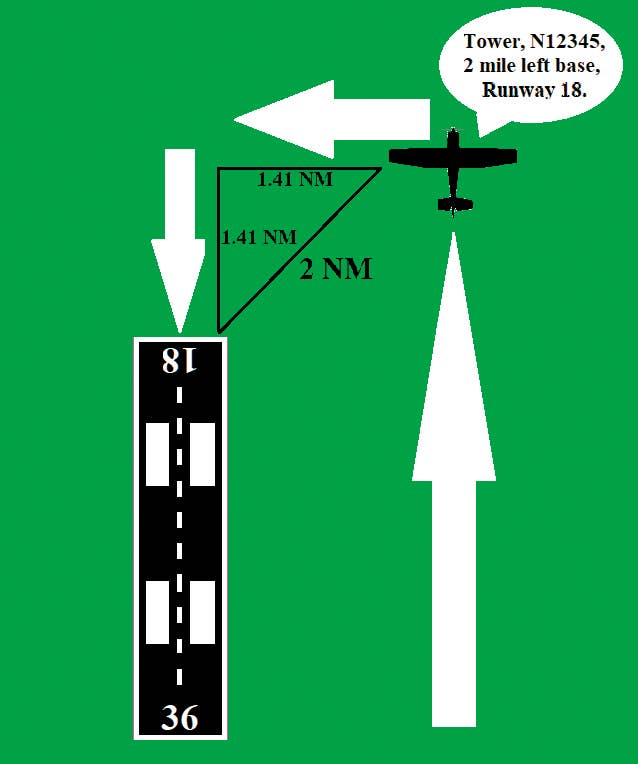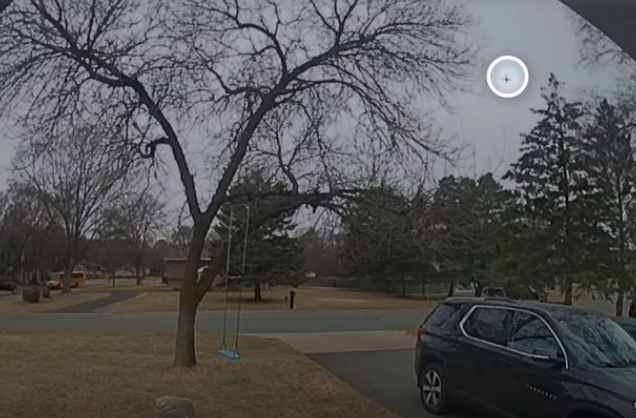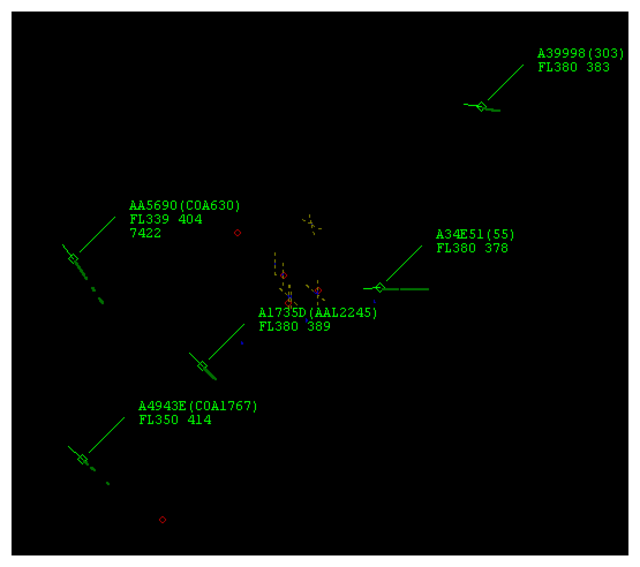Towered Field Ops
It’s Saturday morning at 0730. Weather is VFR and a million, and most of the flight schools and weekend warriors are calling up Ground with the ATIS, ready to go….

What does a two-mile base mean to you? Varying interpretations can add up to trouble.
It’s Saturday morning at 0730. Weather is VFR and a million, and most of the flight schools and weekend warriors are calling up Ground with the ATIS, ready to go. Add student pilots, crosswinds, a runway closure and more. What are the chances of pilots missing something critical or letting expectation bias hit? That risk is not just for the pilots, it is also shared by controllers as well.
Non-Standard Instructions
Any pilot operating in a towered environment should know the basics on where things are. “Enter left downwind” or “Turn crosswind” or perhaps “Report a four-mile final, Runway 18.” Believe it or not, a lot of pilots reply sounding confused when told to go to a certain point.
Such radio talk may go something like this; Tower: “N12345, report a two-mile left base, Runway 18.” N12345: “N12345…uhhh, report left base…18.” In this case pilots would leave the two-mile part out or they ask to say again, as they are unfamiliar with its meaning.
This instruction has multiple interpretations. In this controller’s opinion, it means report when you are turning or entering a base leg that has a distance of two miles (direct distance) from the approach end of the runway. So, you’re on downwind, looking over your shoulder at the numbers. When it’s about two miles, turn base.
Now pull out your math books and remember the Pythagorean Theorem. Remember that the square of the hypotenuse is equal to the sum of the squares of the other two sides. Wait … what? Okay, most pilots won’t run this calculation in their head during a critical phase of flight, but it’s good for illustrational purposes. It’s going to be about a 1.4-mile base from that point and a 1.4-mile final as well. Call ’em a mile and a half. This does not mean go direct to the numbers unless instructed; you should still fly the base and turn final as normal.
Let’s talk about another non-standard instruction. Say you’re due west of the field and hear: “N12345, overfly the field and enter the left downwind, Runway 18.” N12345: “Uhhh … okay N12345, overfly the field and … enter the left downwind … uhhh where do you want me to overfly? What altitude?” Again, we don’t use this one that often either, but it happens.
If you are IFR, I’d highly recommend you verify with Tower before complying with this instruction for the sole reason that the instruction was for you. Unless specifically instructed, the safest place to complete this task is directly over the field and 1000 feet above pattern altitude. It’s best to verify but if you can’t, this is my recommendation. Upon crossing the field, you turn downwind and descend (yes, in the pattern—watch for traffic below) as necessary for the pattern altitude.
Runway Safety
Let’s talk about everyone’s favorite subject, runway safety. Pilots are taught very well when they should enter a runway for departure and when they can “enter” the runway environment upon landing (being cleared to land). But what about after landing and exiting? This is a trending issue at many airports.
Okay you’re ready for departure, not takeoff, and you call Tower to let them know. N12345: “Tower, N12345, ready for departure, Runway 18.” Tower: “N12345, Tower. Hold short Runway 18.” Y’all should know that you have to read back all hold short instructions, thus “Yeah okay, Tower” or “holding” or “Roger” and in this case, not even “wilco” works. “N12345, hold short Runway 18” and nothing short (pun intended) of that will be accepted. Make sure you actually do hold short especially after you say it. Expectation bias is one of those complacent attitudes that should be avoided at all times, for all of us.
Next one is landing. AIM section 4-3-20 goes into detail, but my focus is exiting the runway promptly. What defines exiting a runway? You have successfully exited the runway only when the entire airplane is past the holdshort line. Many runways at the bigger airports will have hold short lines several hundred feet from the runway, so smaller GA airplanes might land and stop after the “white” runway edge line. Technically you’re still on the runway at this point. Keep going to the far side of the hold-short lines.
Please be wary. This could be a reason the airplane behind you is sent around, especially if it’s an air carrier. Don’t forget after you pass that line to stop and contact Ground (when appropriate) before moving onto another controlled movement area. I’ve had pilots exit and keep rolling without saying anything while I have other ground traffic moving, resulting in someone slamming on the brakes to avoid a collision. While I understand you want to keep moving to parking quickly, please refrain. So, if you can, call Ground as you’re exiting the runway, before the hold-short line. You might get to keep on keeping on.
Not Phraseology, But Used...
How many of you have heard, “Give way to the Cessna off your right”? Or perhaps, “Keep it rolling. Runway 18 cleared for takeoff”? Even though these aren’t in the book, they mean exactly what they say. “Give way” means let the other guy go first; “keep it rolling” means don’t stop.
Here is one that some flight schools have started using; “Tower, N12345 request short delay on departure,” suggesting that the student might need more time. Referring the AIM, upon being cleared for takeoff, the pilot is expected to get on the runway and go within reasonable time. So, for a normal takeoff, that’s maybe 15-30 seconds depending on size of airplane. An immediate takeoff is similar to “keep it rolling” but urgency to keep moving is emphasized. “Runway 18, cleared for immediate takeoff. Traffic one-mile final, Cessna.” Feel free to decline clearances that you’re uncomfortable with by using my favorite Sully line, “Unable.” Safety first, but only decline if you really think complying stretches your abilities—or comfort—too far.
Waiving Wake Turbulence
Ever been told, “Hold for wake turbulence”? You read it back to the controller and think, “I’m flying a Cherokee departing from an intersection, I’ll never touch the wake turbulence of that CRJ,” or “I can depart and maneuver around the wake turbulence.” Not many pilots know about this little trick I’m about to tell you. If the departure isn’t a heavy (over 300,000 pounds), you can waive the wake turbulence. Yep, sure can. Pilot: “Tower, N12345 will waive wake turbulence.” Tower: “N12345, Runway 18 at Bravo, wind calm, cleared for takeoff. Caution wake turbulence.” You’re outta there.
A tower controller’s requirements for this are in the 7110.65, section 3-9-7. The ATC bible says, “Separate aircraft weighing 12,500 lbs. or less taking off from an intersection on the same runway (same or opposite direction takeoff) behind a small aircraft weighing more than 12,500 lbs., by ensuring that the aircraft does not start takeoff roll until at least 3 minutes after the preceding aircraft has taken off.” Despite the fact that you are technically able to do this in certain cases, make sure you are physically able to do it as well. Don’t forget, if you are departing behind a heavy, it’s not waivable. If you try, you will hear, “Unable. Departure was a heavy,” and that includes from the approach end of the runway, or opposite direction.
Now that you’re armed with that knowledge, let’s discuss a couple examples of what would and wouldn’t work. For a Cherokee departing behind a C172 at any part of the runway, there’s no wake concerns. A Centurion departing behind a Phenom 300 at the same departure point also has no wake turbulence requirement. But, if the Centurion is at an intersection there’s a three-minute waivable delay. Likewise, a Phenom 300 departing from an intersection behind a full-length B737 gets a waivable three-minute delay.
If applicable, a controller’s requirement from an intersection is three minutes, and two minutes from the approach end if the departure was a heavy. That’s just a minimum; some controllers add a minute for safety, and if they don’t you can add it: “Tower, we’d like to wait another minute for the wake.” By the way, if you depart behind an Antonov AN-225, well, take a picture—there aren’t many of them flying. (Oh, and add another minute or two.)
Obviously if you are waiving the wake turbulence and departing behind something bigger, again, use extreme caution and avoid the wake by taking rotation point, wind, and weather conditions into account.
Help Me Help You … Help Me
Going into a towered field, you’re quite likely to be close to other traffic. Nonstandard instructions and waiving wake turbulence are not on the list of things the FAA will be putting in writing anytime soon. Runway safety is at the top of the FAA’s hit list right now. In some cases, it quite literally falls on deaf ears. It’s one of those things that we should all be doing our best to achieve, to prevent further safety reg‑ ulations being written in blood. ATC can say, “Enter a two-mile base” and if the pilot has no idea what that means, they could come up with something unsafe or they could clarify. If ATC or pilots can’t get their point across, they should utilize basic language. Consider yourself armed with the knowledge to operate better, especially in crowded spaces. Fly safe!
Expectation Bias
I was working Ground on a relatively busy day, and while most of the airplanes were listening to my instruction orchestra, I got one more pilot (based at my airport) call for taxi. To preface, this guy will normally taxi out faster than your average Cessna, and almost all of the time he requests an intersection departure and gets his takeoff clearance almost immediately. He is also familiar with waiving wake turbulence. Yeah, he always seems to be in a hurry. For this story, we’ll say he flies an experimental.
On this one particular day, with up to 10 aircraft waiting to depart and more in the pattern, I advised him that we were unable to accommodate an intersection departure at that time. He was cool with it and understands the tower gets busy sometimes, so he taxied to the end and even told me, “I will be ready at the end.” I told him I would tell the tower controller and kept working. Knowing that this pilot flies in and out on a daily basis and seeing his skills, the controllers know he doesn’t play around and when he says he is ready to roll, he is normally rolling by the end of the takeoff clearance.
He got to the end of the runway and right away, “Tower N12345, ready at the end.” Tower replies with, “Hold short for traffic one-mile final.” He reads back the hold short as he physically crosses the line and was about to roll. My ground traffic had died down, so I was monitoring Tower as another pair of eyes. As Tower told him to hold, Tower was scanning the other runway for traffic and the controller in charge (CIC) was on the phone. I heard the pilot read it back, saw him cross, and with a Challenger 600 on short final, I yelled, “SEND HIM AROUND!”
By the time the tower controller looked over and standard reaction time kicked in, the pilot of the experimental had stopped and keyed up and said, “Sorry tower I crossed the line.” Tower immediately sent the Challenger around and asked the experimental if he could do a 180 and exit. He complied. All of this happened in a matter of 10 seconds.
After all was said and done, the Challenger went left closed traffic and landed without incident, and the pilot flying the experimental was deviated. He sat in the run-up area for a few minutes after this happened, then departed on his way. I don’t blame him; he was probably getting his mind right. About an hour later he called the tower as instructed and straight up admitted that he wasn’t in the right state of mind. With a lot of personal problems present in his mind, his PAVE checklist (Personal, Aircraft, enVironment, External pressures) went straight out the window. The CIC gathered his information and encouraged him not to fly unless he is feeling good and in the right state of mind. Expectation bias is as real as wake turbulence. Just because pilots can’t see it, know that it’s there and how to avoid it.
Elim Hawkins enjoys controlling airplanes, especially when they do what they say they’ll do and what he tells them to do!
For more great content like this, subscribe to IFR!






